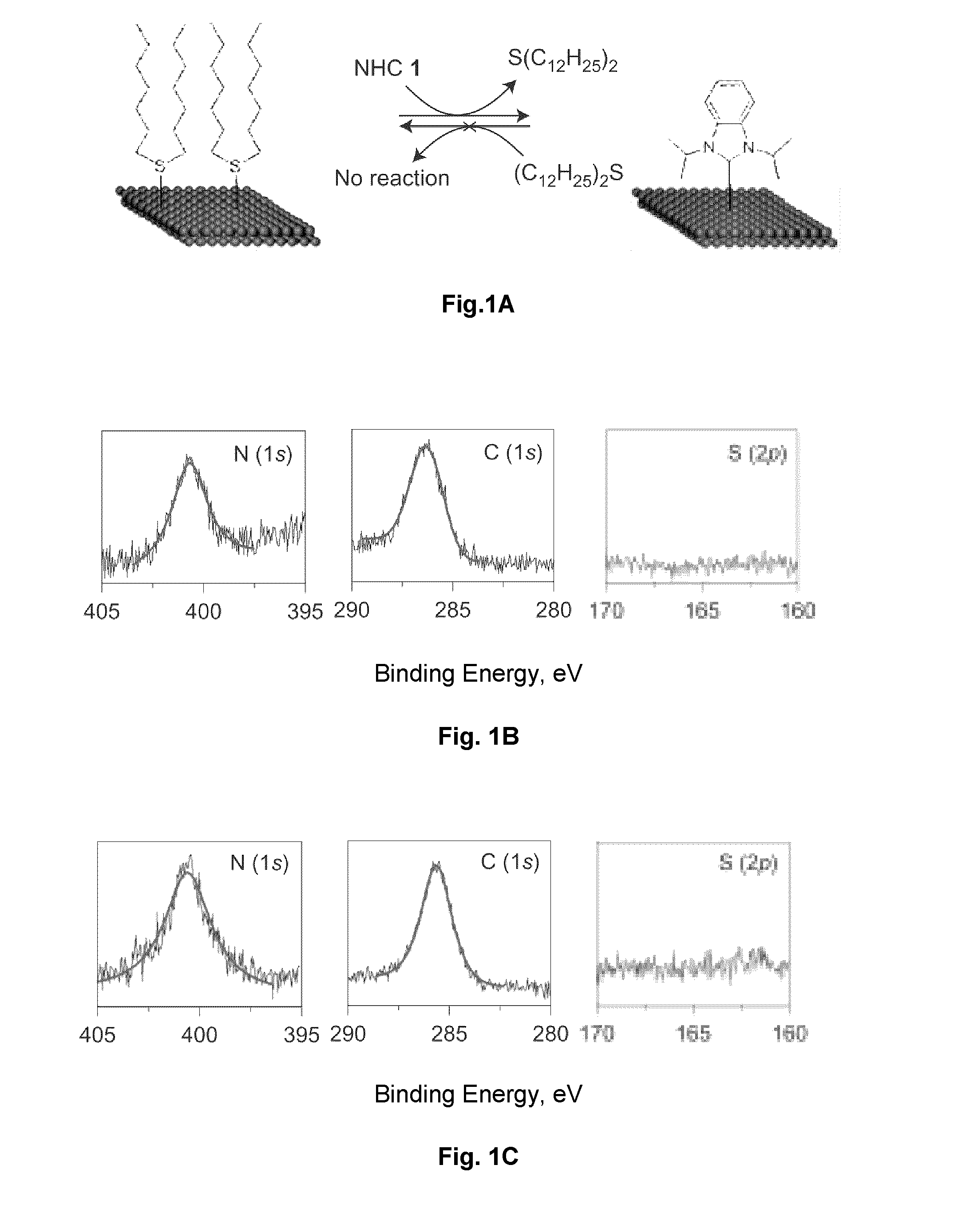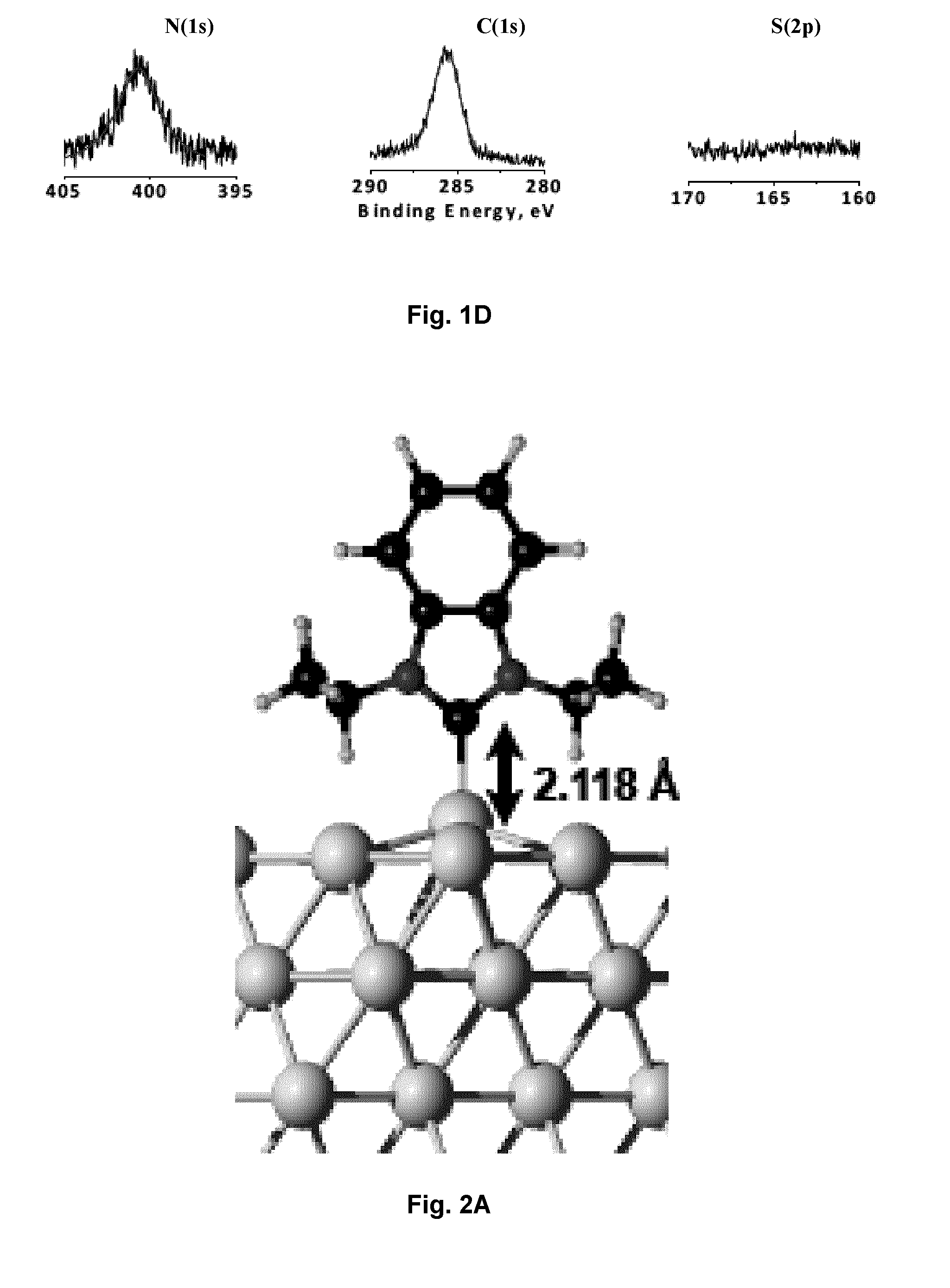Carbene-Functionalized Composite Materials
- Summary
- Abstract
- Description
- Claims
- Application Information
AI Technical Summary
Benefits of technology
Problems solved by technology
Method used
Image
Examples
working examples
[0321]Synthesis and deposition of carbenes were carried out in a nitrogen atmosphere in a glovebox (M. Braun) with oxygen and water levels ppm. Solvents were purified on a PureSolv Solvent Purification system, distilled, degassed and stored over 4 Å molecular sieves prior to use. Reactants were obtained from Aldrich Chemical Company (Oakville, Ontario, Canada) unless otherwise specified. Hydrogen tetrachloroaurate [HAuCl4] was synthesized by the oxidation of gold metal through dissolution in aqua regia. Aqua regia was prepared as a mixture of concentrated nitric and hydrochloric acid (1:3 ratio v / v). Gold wire was dissolved in an appropriate volume of aqua regia solution such that no solid remained. Careful evaporation of the solution after 24 hours yielded chloroauric acid tetrahydrate as a yellow solid. Au(111) was purchased from Georg Albert PVD—Beschichtungen of Hauptstr, Germany. Polycrystalline gold refers to gold that was adhered to a silicon wafer (available from Western nan...
example 1
Synthesis of N-Heterocyclic Carbenes
Example 1a
Synthesis of 1,3-Dihydro-1,3-bisisopropyl-2H-benzimidazol-2-ylidene, (“IPrBenz” or “NHC-1”)
[0325]1,3-Diisopropyl-1H-benzo[d]imidazole-3-ium iodide (317 mg, 0.908 mmol) [Huynh, H. V., et al. Organometallics 25, 3267-3274 (2006)] was dissolved in 10 mL of anhydrous THF in a glove box. A solution of KOtBu (108 mg, 0.908 mmol) in THF (20 mL) was added dropwise over an hour. The reaction was stirred for an additional hour. The THF was then evaporated under vacuum, and the resulting residue was dissolved in toluene and filtered through Celite®. Evaporation of the filtrate gave the desired free carbene as a yellow oil in 68% yield. 1H NMR (C6D6) δ (ppm): 7.3-7.2 (br, 4H, PhH), 4.52 (sept, JHH=6.6 Hz, 2H, CH—(CH3)3), 1.63 (d, JHH=6.65 Hz, 12H, CH3).
example 1b
Synthesis of 2,4-Dihydro-2,4,5-triphenyl-3H-1,2,4-triazol-3-ylidene (“Enders carbene” or “NHC-2”); 1,3-dihydro-1,3-bis(2,4,6-trimethylphenyl)-2H-imidazol-2-ylidene (“IMes” or NHC-3); 1,3-bis(2,4,6-trimethylphenyI)-2-imidazolidinylidene (“SIMes” or “NHC-4”); and 1,3-dihydro-1,3-bis(2,6-diisopropylphenyl)-2H-imidazol-2-ylidene (“IPr” or NHC-5)
[0326]These carbenes were were prepared using a similar method as described in Enders, D., et al. Angew. Chem. Int. Ed. 34, 1021 (1995); Arduengo, A. J., et al. J. Am. Chem. Soc. 114, 5530 (1992); Arduengo, A. J., et al. Tetrahedron 55, 14523-14534(1999); and Jafarpour, J., et al. J. Organomet. Chem. 606, 49-54 (2000). Structural formulae are shown in Table 1. As a person of skill in the art will recognize, structural formula of free NHCs can be deduced by looking at a structural formula of an NHC on gold, and changing the bond that links the carbene carbon to the gold surface into the absence of a bond, with a lone pair of electrons on the carbe...
PUM
| Property | Measurement | Unit |
|---|---|---|
| Temperature | aaaaa | aaaaa |
| Fraction | aaaaa | aaaaa |
| Fraction | aaaaa | aaaaa |
Abstract
Description
Claims
Application Information
 Login to View More
Login to View More - R&D
- Intellectual Property
- Life Sciences
- Materials
- Tech Scout
- Unparalleled Data Quality
- Higher Quality Content
- 60% Fewer Hallucinations
Browse by: Latest US Patents, China's latest patents, Technical Efficacy Thesaurus, Application Domain, Technology Topic, Popular Technical Reports.
© 2025 PatSnap. All rights reserved.Legal|Privacy policy|Modern Slavery Act Transparency Statement|Sitemap|About US| Contact US: help@patsnap.com



